I’ve done a series of experiments to find out how best to brine chicken breasts. What kind of salt should you use? Cold or warm water? And, most importantly, how long do the chicken breasts need to brine for? I’ve tested it all and have the answers for you here!
No dry, tasteless chicken here! I’ve done all the testing for you, so you can cook your best chicken breasts ever. It’s quicker and easier than you think. Once you’ve experienced it, you’ll wonder why you didn’t start doing this earlier! And if you have thighs instead, read the specifics on brining chicken thighs.
- Video: Brining Chicken Breasts
- What is Brining and How Does It Work?
- What Goes In A Brine?
- Should My Brine Be Warm Or Cold?
- How Long Should I Brine Chicken Breasts?
- Can You Freeze Brined Chicken Breasts?
- How To Cook Chicken Breasts After Brining
- Podcast Episode: Brining Chicken Breasts
- Recipe: How To Brine Chicken Breasts

Want To Save This Recipe?
Enter your email address & I’ll send this recipe straight to your inbox to save for later! Plus, you’ll get new recipe ideas from me every week!
Video: Brining Chicken Breasts
What is Brining and How Does It Work?
Brining is simply soaking your meat in a salt water solution before cooking it. It’s been debated in the culinary literature about what is actually happening here, and scientific words like osmosis and diffusion are used quite a bit. But what we do know is that using a brine changes meat in three ways.
First, meats soak up salt water more easily than plain water. Therefore, what you’re doing is adding moisture to the meat, which, once it’s cooked, makes the meat itself seem moister.
Second, the salt changes the texture of the meat. It’s a type of denaturing. So, meat that is brined also has a more tender texture.
Finally, because we’re working with salt and because that salt is dissolved in water and then getting right into the meat, when you brine something, you are essentially seasoning it on the inside.
All of that is going on and the result is meat (or chicken breasts, in this case) that are juicier, more tender, and more flavorful. It’s a win-win-win!
You can read more about the science behind brining and the osmosis debate here.
Note that there is another way that you can brine chicken breasts and other cuts of meat. It’s called a dry brine and doesn’t use water. Instead, you sprinkle the meat with salt and leave it uncovered in the fridge. It’s actually a very convenient technique to learn, but is not what we’re talking about here today. If you’d like to learn more about dry brining, head over here. Note that dry brining is especially useful for large pieces of meat, like turkey, since you don’t need to find a large container to hold them and the water. Learn how to dry brine a turkey here.
What Goes In A Brine?
All that is needed for a brine is salt and water. Sometimes additional seasonings or sugar are added as well. I used my standard brine recipe for testing, which yields enough brine to cover about four chicken breasts.
My standard brine recipe is essentially: 4 cups of cold water and 6 tablespoons Diamond Crystal kosher salt OR 4 1/2 tablespoons Morton’s kosher salt OR 3 tablespoons fine or table salt.
Note that it really matters what kind of salt you have and how much you use. The salt crystals in these types are all of different sizes and if you use the incorrect type or incorrect amount, you will end up with a brine that is either way too salty or not salty enough.
To make the brine, all you need to do is mix together the salt and the water. It’s a large amount of salt though so it can take a minute or two for it to dissolve. It will though. Just stir it together and keep stirring until it’s less cloudy and there’s no more salt undissolved at the bottom.
Some people like to add optional ingredients for flavor such as peppercorns, crushed garlic, rosemary, thyme and/or sage sprigs, bay leaves, whole cloves, or other herbs and spices. I don’t think it really adds much flavor to chicken breasts though, because it’s a shorter brine time than you would do for things like a whole chicken or turkey.
However, as you’ll see below, the sweet spot for brining chicken breasts is 30-60 minutes. If I know I’m going to have mine in the brine for 60 minutes, I add in 1 tablespoon of garlic granules. The full hour with the chicken in the garlicky salty brine is seriously amazing! Also, if I’m going to brine for 60 minutes and I want to impart even more flavor into the chicken breasts, I’ll use my extra-flavorful food processor brine, which I developed for brining turkey. It’s the best turkey brine out there, full of onion, garlic, and fresh herbs, combined in a way that really gets the flavors into the meat.

Should My Brine Be Warm Or Cold?
One of the first tests that I did was to compare the use of warm tap water to cold tap water in the brine. The reason for doing this is that there’s a popular baked chicken breasts recipe over here that swears by using warm water in the brine. I was really disappointed that it didn’t work for me though, not with any of the different times that I tested. When compared with the cold water brine, the warm-brined chicken breast was less tender and less juicy than the cold-brined chicken breast after baking.
So, the answer is to use cold tap water in your brine. Why might this be the case?
While I’m not a food scientist, my best guess is that the warm water expanded the molecules on the outside of the chicken which prevented as much penetration of the brine into the chicken. The warm tap water did help the salt dissolve more quickly, but that seemed to be the only advantage to this method.
In one of the 15-minute warm brine tests, I also added aromatics like fresh onion slices, garlic, and herbs to see if the warm water would help these flavors penetrate and infuse the chicken breast the same way they would with longer brining times. Unfortunately, they did not.
How Long Should I Brine Chicken Breasts?
For this part of the brining experiments, I wanted to compare chicken breasts that had been brined for different amounts of time. As mentioned, the brining solution I used for testing is my standard brine recipe, with cold tap water. I’ve also done similar tests for brining pork chops as well as brining pork loin and my pork tenderloin brine, so make sure to take a look at those results as well.
Note that for the 15-minute version, I placed the brine and the boneless skinless chicken breasts into a bowl and left it right on the counter to soak. 15 minutes is a safe amount of time for the chicken to be left out. You can also leave it on the counter if doing a 30 minute brine. Any longer than that, and you should refrigerate the chicken in the brine to keep the food safe from bacteria like Campylobacter and Salmonella.
In the chart below, I share my results of testing the brine for various times. You’ll see that the sweet spot is between 30 minutes to one hour.
Chart: Chicken Breast Texture and Flavor After Different Amounts of Time in Brine
| BRINING TIME | RESULTS |
|---|---|
15 minutes | Lightly salted flavor, no detectable change in texture. |
30 minutes | Lightly salted flavor, slightly more tender than the 15-min brine, no detectable change in texture. |
1 hour | Perfectly seasoned, juicy, tender, noticeable difference in texture and tenderness. See picture below. |
2 hours | On the edge of being overly salty, but not off-putting, especially if it will be served with a sauce or other things. Very juicy and tender. The texture is similar to the 1 hour brine. |
4 hours | This is too salty for me. It might be okay if mixed with mayonnaise for a chicken salad, but in my opinion, it’s too salty to be eaten on its own. The texture is significantly different, more like deli meat. |
8 hours | I couldn’t get through a bite of this, it’s just too salty, and the texture is almost spongy. |
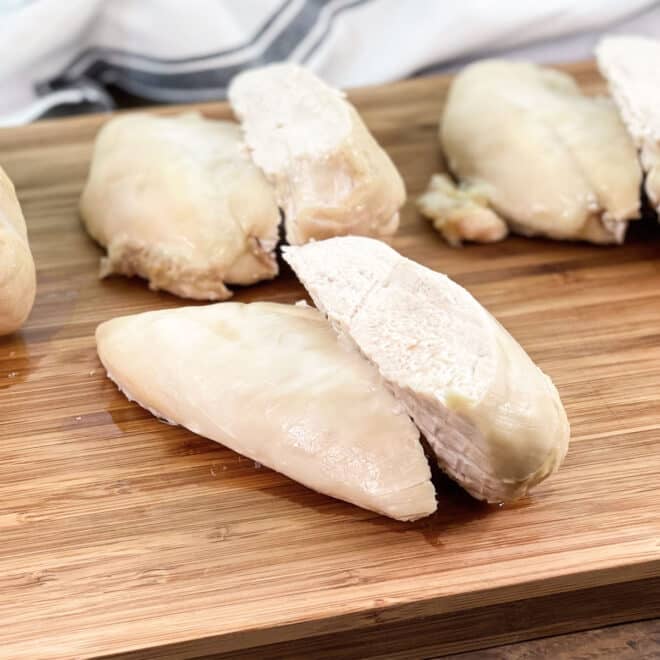
Can You Freeze Brined Chicken Breasts?
Yes! You can brine and then freeze your chicken to be cooked at a later time. Brine the chicken for 30 – 60 minutes, drain the excess brine, and store in the freezer. The brine gets suspended in the meat as frozen water droplets.
I suggest using the chicken within six months, after that there is a chance that the ice crystals will affect the texture of the meat.
How To Cook Chicken Breasts After Brining
After the chicken has been brined, you don’t have to cook it right away. It can be removed from the brine and kept in the refrigerator, covered, for up to three days, or wrapped well and stored in the freezer for up to two months.
When you’re ready to cook, pat the chicken dry but don’t rinse it off. Why not? Rinsing the chicken doesn’t remove any salt from it. All that you really do when rinsing any kind of meat or poultry is increase the amount of bacteria in your sink and kitchen work area. The water bouncing off of the chicken has been shown to cause more bacteria than helping with anything.
From there, you can bake, grill, or use whatever your favorite method for chicken is. I’ve got instructions for a few different methods for you here:
Remember though, you shouldn’t add any additional salt called for in the recipe since you brined first and the chicken is already well-salted.
I hope you learned a lot about brining chicken breasts and I can’t wait to hear how it all works out for you. Plus, if you loved learning about my chicken breast testing, you’ll also enjoy reading about my best brined chicken wings too. Have a great day!
Podcast Episode: Brining Chicken Breasts
Listen to me explain briefly about How To Brine Chicken Breasts, with some great tips along the way, by clicking the play button below:
Listen to more Recipe of the Day episodes here.
Print
Recipe: How To Brine Chicken Breasts
- Prep Time: 5 minutes
- Cook Time: 30 minutes
- Total Time: 35 minutes
- Yield: 4 servings 1x
- Category: Entree
- Method: Stir
- Cuisine: American
DESCRIPTION
After doing a series of tests and comparisons, this is the recipe and method that I’ve found works best for brining chicken breasts.
Ingredients
- 4 cups cold tap water
- 4 and 1/2 Tbsp. Morton’s kosher salt*
- 1 Tbsp. garlic granules (optional)
- 4 (6oz) boneless skinless chicken breasts
Instructions
- In a medium-sized bowl stir together water and salt until salt is dissolved.
- If you are planning to brine for over 45 minutes, stir in the garlic granules (otherwise the flavor won’t penetrate).
- Add the chicken breasts. Make sure they’re all submerged. If not, use a narrower bowl or a zipper bag.
- If brining chicken for more than 30 minutes, transfer brine and chicken to refrigerator. If brining for under 30 minutes, leave on counter.
- Allow chicken to sit in brine for 15 minutes to 2 hours. See chart above to determine optimum time. My preference is 1 hour.
- Remove chicken from brine. Discard brine. Pat chicken dry with paper towels.
- Cook chicken immediately (try these baked chicken breasts or these grilled chicken breasts), or refrigerate covered for 3 days, or wrap well for the freezer and freeze for up to 2 months, and then cook.
Love this recipe? I’d appreciate it if you could scroll down and add a *5 star rating* to help others know they’ll love it as well!
Notes
*Different kinds of salt have different sized crystals so you need different amounts depending on the type. Use 6 tablespoons of Diamond Crystal kosher salt, OR 4 and 1/2 tablespoons of Morton’s kosher salt, OR 3 tablespoons of fine or table salt.
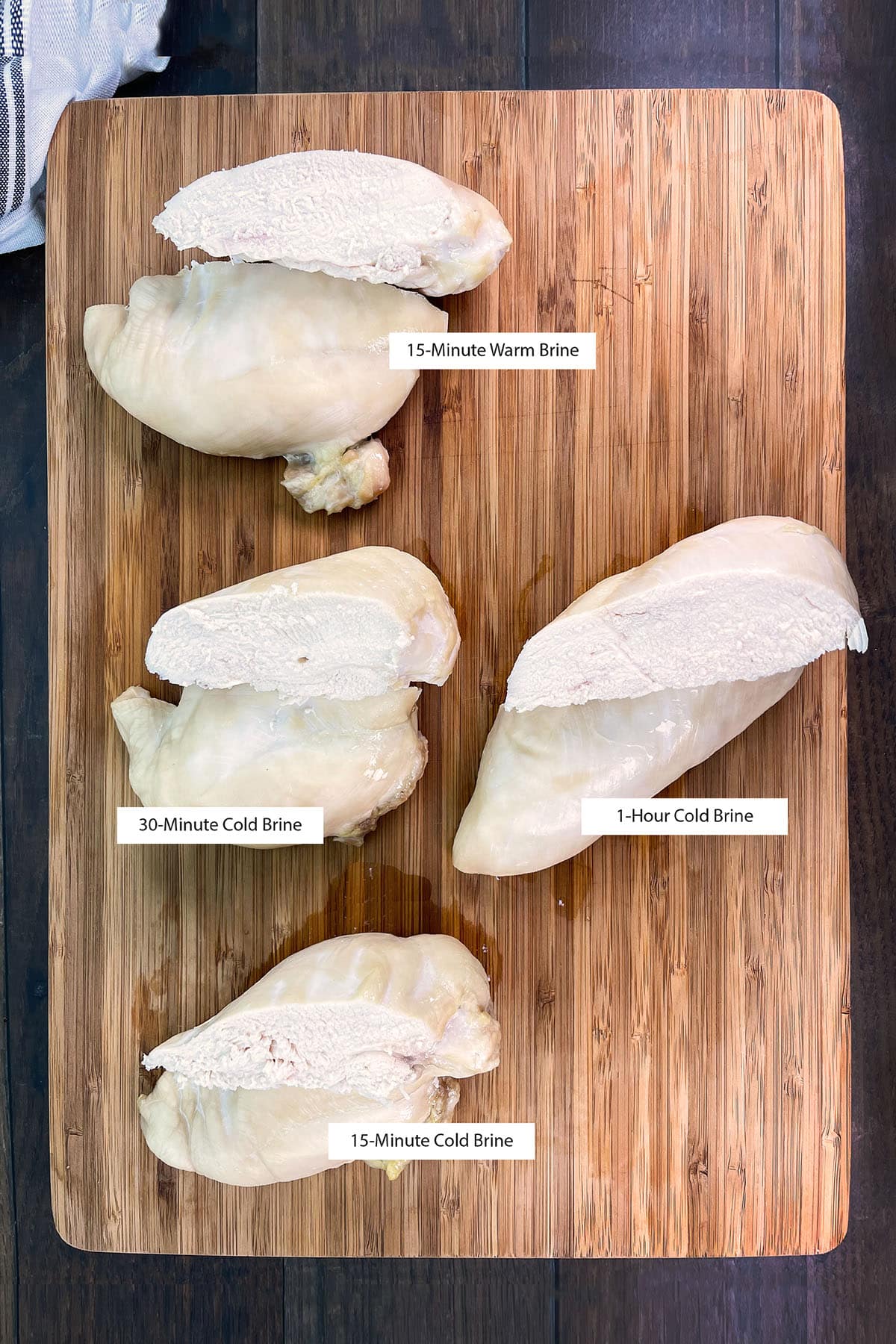

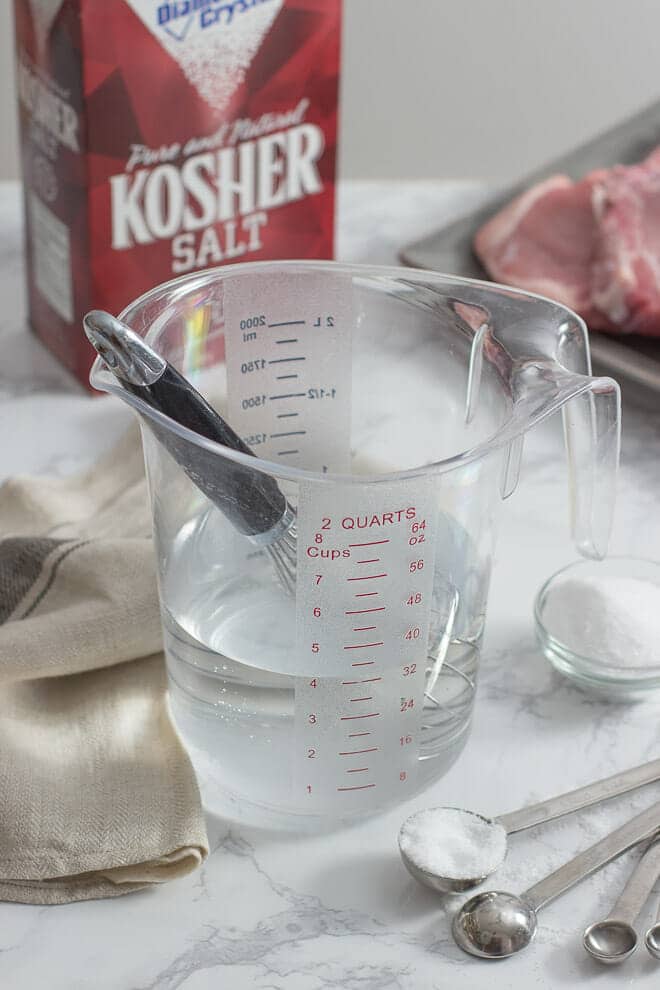
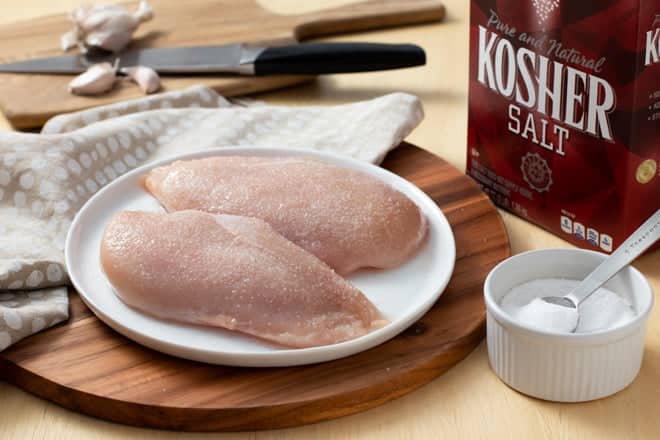
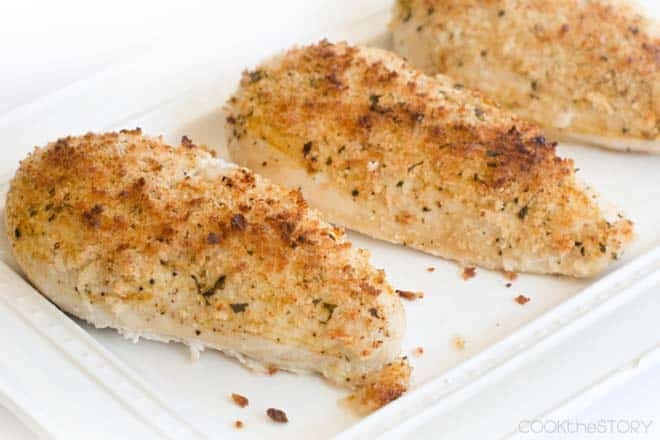




















Ok so I brined for an hour then did the buttermilk garlic bath pre barbecue 😱best chicken OMG Flavourful and moist! Thank you for sharing your experience with brining. You’re my hero!
Oh, that’s wonderful to hear, Corrie! Thanks for coming back with your results, sorry I didn’t see your question sooner.
Love the way you laid out the information! Any thoughts on me putting the brined chicken into a buttermilk garlic bath prior to barbecuing ( after one hour brining)
Should I cover the chicken while in the brine solution?
Nancy, your container of chicken in brine does not have to have a lid or be covered. It can be but doesn’t have to be. However, it is important that the chicken be fully submerged in the liquid.
The container with the chicken can stay at room temperature for 30 minutes, covered or uncovered. If you’re brining for longer than that, put it into the fridge, uncovered or covered.
Will pink Himalayan salt work? And if so, how much should I use?
Lise, great question! I’ve never tried it. However, there’s a great conversion chart over here on the Morton website that I think will help you convert between the two kinds of salt. https://www.mortonsalt.com/article/salt-conversion-chart/
Dumb question, I purchased chicken cutlets and was thinking about doing a brine but am concerned that since the breast has been sliced in half that it will soak up more salt than a normal chicken breast. Thoughts?
Alissa, I haven’t tried chicken cutlets specifically, but I have had success brining chicken breast that is cut into bite-sized pieces. It only needs 20-30 minutes in the brine mixture though. If you leave it for longer than that, it will get too salty, yes.
This is by far the most concise, perfectly-accurate chicken brining recipe I’ve tried. I usually make my own brine but wanted to try something different. This is far simpler, precise (measurement by brand of salt, and timing). The chicken came out perfectly. On the pellet grill @250F until internal temp of 157F and it was juicy, tender, and flavorful.
Thank you, Baba! I’m so glad it was helpful.
Silly question??
For the one hour brine – in the fridge or on the counter??
Dumb dad cooking 😂
Not a problem, Paul! You can safely leave the chicken on the counter for up to half an hour, but for brining for an hour it needs to be in the fridge. Enjoy!
Can’t wait to try
I tried this recipe and it was delicous. Highly recommend it. Thank you for the recommendations!
You’re welcome, Amin! Glad I could help.
I brine my chicken breasts with Hit and Miss results and it is really nice to see it brought down to exact amounts and times. Definitely saving this article and going to look at the links in the article to similar things. Thanks for doing the research.
You’re welcome, Karen! This will definitely help you get more consistently great results.
Easy! Super moist chicken breasts!
Gerri, So happy you liked them! Thanks for letting me know :-)
If I double the amount of chicken, do I double the amount of brine?
Yes, you probably need to double the amount of brine as well because you need to have enough for all the chicken to be submerged/covered by the brine. Enjoy, Amy!
Giving results using various brine times very helpful and I really appreciated the measurements regarding different salt choices. I used the cold water and 30 min brine suggestion. While brining, I cut my vegs to sauté, and when chicken done, cut them for a great pot pie. 30 mins and cold water method is my choice for chx breasts. TKS.
I’m happy all the information was helpful for you, Laura! Thanks for coming back to let me know.
Wonderful article, thanks so much!
You’re welcome, Michelle!
Can you marinate after brining? Should you still only pat dry after brining before marinating? Anything to avoid? Thank you!!
Tori, I wouldn’t do a wet marinade after brining. I think some of the liquid you got into the chicken could come out into the marinade and defeat the purpose. Instead, I would recommend that you try adding flavorful ingredients to your brine.
The best way that I know how to do this is to make a brine that is also a flavor slurry. You essentially take the ingredients that you want to have in your marinade (garlic, onion, herbs, spices) and blend them up in a blender or food processor with the salt and water mixture. Then, as your chicken is brining, it is also sucking in all that flavor. Here is a recipe for doing this with turkey, but note that there is a recipe for doing a smaller amount, like you’d need for some chicken breasts, about halfway down. https://cookthestory.com/the-best-turkey-brine-recipe/ Enjoy!
Will this brining work for chicken breast cooked on the grill?
You can absolutely brine your chicken breasts like this before grilling, Marty! Get more tips for grilling here – https://cookthestory.com/grill-chicken-breasts-that-are-juicy/
Your on target with this recipe! My chicken breasts have never been this tender and juicy. Thank you.👍
You’re welcome, Gil! So happy that it helped.
Excellent! My sister-in-law made this while we were on vacation in the outer Banks. It was an absolute hit. She made a hot bacon vinaigrette dressing with spinach and other veggies. We added the chicken to the spinach salad!
That sounds amazing, Tina! Thank you for sharing how you used it.
This sounds wonderful!love that you explained things so completely, yet simply. Not an easy skill to develop!
Questions: 1. I prefer bone-in for grilling and frying – should I bring them longer?
2. The brine I have used for wings calls for brown sugar, and hot pepper flakes. Would it be correct to surmise this wouldn’t work as well on larger pieces?
Thank you!
Thanks, J! For the bone-in, I would go on the longer side of the above recommendations, so 1.5 hours. You can add the sugar and hot pepper flakes. I find that some flavor transfers as long as the brining is happening for at least 45 minutes. I can’t wait to hear how it all turns out!
I’ve been brining my chicken for many years now. This is for sure my new go to recipe. 👌